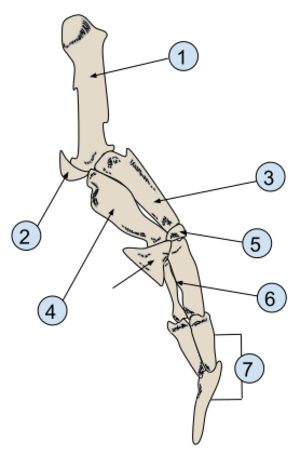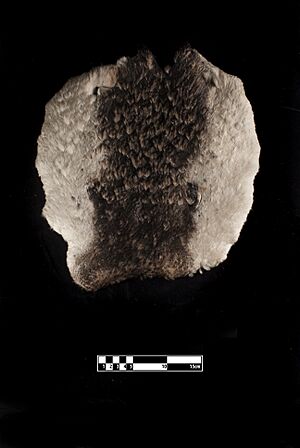Penguin facts for kids
Quick facts for kids Penguins |
|
|---|---|
 |
|
| Chinstrap penguin (Pygoscelis antarctica) |
|
| Scientific classification |
|
| Kingdom: | Animalia |
| Phylum: | Chordata |
| Class: | Aves |
| Clade: | Austrodyptornithes |
| Order: | Sphenisciformes Sharpe, 1891 |
| Family: | Spheniscidae Bonaparte, 1831 |
| Modern genera | |
|
Aptenodytes |
|
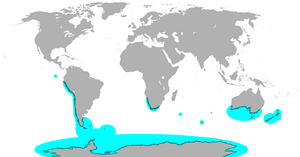 |
|
| Breeding range of penguins, all species (aqua); some species have wider seasonal migration ranges | |
Penguins are a group of aquatic flightless birds from the family Spheniscidae of the order Sphenisciformes.
Contents
Name

The word penguin first appears in literature at the end of the 16th century as a synonym for the great auk. When European explorers discovered what are today known as penguins in the Southern Hemisphere, they noticed their similar appearance to the great auk of the Northern Hemisphere and named them after this bird, although they are not closely related.
Adult male penguins are sometimes called cocks, females sometimes called hens; a group of penguins on land is a waddle, and a group of penguins in the water is a raft.
Distribution
Penguins live almost exclusively in the Southern Hemisphere: only one species, the Galápagos penguin, is found north of the Equator, but this is only made possible by the cold, rich waters of the Antarctic Humboldt Current that flows around these islands.
Today, larger penguins generally inhabit colder regions, and smaller penguins inhabit regions with temperate or tropical climates. There was a great diversity of species in subantarctic regions, and at least one giant species in a region around 2,000 km south of the equator 35 mya, during the Late Eocene, a climate decidedly warmer than today.
Penguins are not found only in cold climates, such as Antarctica. In fact, only a few species of penguin actually live so far south. Several species live in the temperate zone; one. Also, though the climate of the Arctic and Antarctic regions is similar, there are no penguins found in the Arctic.
Major populations of penguins are found in Angola, Antarctica, Argentina, Australia, Chile, Namibia, New Zealand, and South Africa.
Description
Highly adapted for life in the ocean water, penguins have countershaded dark and white plumage and flippers for swimming. The biggest penguins may stand nearly 4 feet tall (110 cm) and can weigh almost 100 pounds (40 kg). The smallest kinds are only about one foot (32 cm) tall.
Isabelline penguins
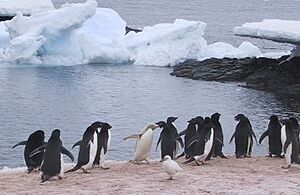
Perhaps one in 50,000 penguins (of most species) are born with brown rather than black plumage. These are called isabelline penguins. Isabellinism is different from albinism. Isabelline penguins tend to live shorter lives than normal penguins, as they are not well-camouflaged against the deep and are often passed over as mates.
Movement
Penguins' swimming looks very similar to birds' flight in the air. Within the smooth plumage a layer of air is preserved, ensuring buoyancy. The air layer also helps insulate the birds in cold waters. On land, penguins use their tails and wings to maintain balance for their upright stance.
On land, penguins either waddle on their feet or slide on their bellies across the snow while using their feet to propel and steer themselves, a movement called "tobogganing", which conserves energy while moving quickly. They also jump with both feet together if they want to move more quickly or cross steep or rocky terrain.
How do penguins survive low temperatures?
Penguins have a thick layer of insulating feathers that keeps them warm in water (heat loss in water is much greater than in air).
The flippers of penguins have at least three branches of the axillary artery, which allows cold blood to be heated by blood that has already been warmed and limits heat loss from the flippers. This system allows penguins to efficiently use their body heat and explains why such small animals can survive in the extreme cold.
Camouflage
All penguins are countershaded for camouflage – that is, they have black backs and wings with white fronts. A predator looking up from below (such as an orca or a leopard seal) has difficulty distinguishing between a white penguin belly and the reflective water surface. The dark plumage on their backs camouflages them from above.
Diet
Most penguins feed on krill, fish, squid and other forms of sea life which they catch with their bills and swallow whole while swimming. A penguin has a spiny tongue and powerful jaws to grip slippery prey.
The small penguins do not usually dive deep; they catch their prey near the surface in dives that normally last only one or two minutes. Larger penguins can dive deep in case of need.
Behaviour

Penguins for the most part live in large colonies, with the exception of the yellow-eyed and Fiordland species. These colonies may range in size from as few as 100 pairs for gentoo penguins to several hundred thousand in the case of king, macaroni and chinstrap penguins. Penguins have developed a high level of social interaction; all penguin species communicate through using many visual and vocal displays.
Breeding
Penguins form pairs for a breeding season. Most penguins lay two eggs in a clutch, although the two largest species, the emperor and the king penguins, lay only one. With the exception of the emperor penguin, where the male does it all, all penguins share the incubation duties. These incubation shifts can last days and even weeks as one member of the pair feeds at sea.
Penguins generally only lay one brood; the exception is the little penguin, which can raise two or three broods in a season.
Penguin eggs are smaller than any other bird species when compared proportionally to the weight of the parent birds; at 52 g (2 oz), the little penguin egg is 4.7% of its mothers' weight, and the 450 g (1 lb) emperor penguin egg is 2.3%. The relatively thick shell forms between 10 and 16% of the weight of a penguin egg, presumably to reduce the effects of dehydration and to minimize the risk of breakage in an adverse nesting environment. The yolk, too, is large and comprises 22–31% of the egg. Some yolk often remains when a chick is born, and is thought to help sustain the chick if the parents are delayed in returning with food.
When emperor penguin mothers lose a chick, they sometimes attempt to "steal" another mother's chick, usually unsuccessfully as other females in the vicinity assist the defending mother in keeping her chick. In some species, such as emperor and king penguins, the chicks assemble in large groups called crèches.
Conservation status
The majority of living penguin species have declining populations. According to the IUCN Red List, their conservation statuses range from Least Concern through to Endangered.
| Species | IUCN Red List Status | Trend | Mature Individuals | Last assessment |
|---|---|---|---|---|
| Emperor penguin, Aptenodytes forsteri | Near Threatened | Unknown | 2018 | |
| King penguin, Aptenodytes patagonicus | Least Concern | Increasing | 2018 | |
| Little penguin, Eudyptula minor | Least Concern | Stable | 469,760 | 2018 |
| Southern rockhopper penguin, Eudyptes chrysocome | Vulnerable | Decreasing | 2,500,000 | 2018 |
| Macaroni penguin, Eudyptes chrysolophus | Vulnerable | Decreasing | 2018 | |
| Northern rockhopper penguin, Eudyptes moseleyi | Endangered | Decreasing | 480,600 | 2018 |
| Fiordland penguin, Eudyptes pachyrynchus | Vulnerable | Decreasing | 2,500-9,999 | 2018 |
| Snares penguin, Eudyptes robustus | Vulnerable | Stable | 63,000 | 2018 |
| Royal penguin, Eudyptes schlegeli (disputed) | Near Threatened | Stable | 1,700,000 | 2018 |
| Erect-crested penguin, Eudyptes sclateri | Endangered | Decreasing | 150,000 | 2016 |
| Yellow-eyed penguin, Megadyptes antipodes | Endangered | Decreasing | 2,528-3,480 | 2018 |
| Adélie penguin, Pygoscelis adeliae | Least Concern | Increasing | 7,580,000 | 2018 |
| Chinstrap penguin, Pygoscelis antarctica | Least Concern | Decreasing | 8,000,000 | 2018 |
| Gentoo penguin, Pygoscelis papua | Least Concern | Stable | 774,000 | 2018 |
| African penguin, Spheniscus demersus | Endangered | Decreasing | 50,000 | 2018 |
| Humboldt penguin, Spheniscus humboldti | Vulnerable | Decreasing | 32,000 | 2018 |
| Magellanic penguin, Spheniscus magellanicus | Near Threatened | Decreasing | 2018 | |
| Galápagos penguin, Spheniscus mendiculus | Endangered | Decreasing | 1,200 | 2018 |
Penguins and humans

Penguins have no special fear of humans and will often approach groups of people. This is probably because penguins have no land predators in Antarctica or the nearby offshore islands. They are preyed upon by other birds like skuas, especially in eggs and as fledglings. Other birds like petrels, sheathbills, and gulls also eat the chicks. Dogs preyed upon penguins while they were allowed in Antarctica during the age of early human exploration as sled dogs, but dogs have long since been banned from Antarctica. Instead, adult penguins are at risk at sea from predators such as sharks, orcas, and leopard seals. Typically, penguins do not approach closer than around 9 feet (2.7 meters), at which point they appear to become nervous.
In June 2011, an emperor penguin came ashore on New Zealand's Peka Peka Beach, 3,200 kilometres (2,000 mi) off course on its journey to Antarctica. Nicknamed Happy Feet, after the film of the same name, it was suffering from heat exhaustion and had to undergo a number of operations to remove objects like driftwood and sand from its stomach. Happy Feet was a media sensation, with extensive coverage on TV and the web, including a live stream that had thousands of views and a visit from English actor Stephen Fry. Once he had recovered, Happy Feet was released back into the water south of New Zealand.
Interesting facts about penguins
- Penguins spend about half of their lives on land and the other half in the sea.
- The largest living species is the emperor penguin (Aptenodytes forsteri): on average, adults are about 1.1 m (3 ft 7 in) tall and weigh 35 kg (77 lb).
- The smallest penguin species is the little blue penguin (Eudyptula minor), also known as the fairy penguin, which stands around 30–33 cm (12–13 in) tall and weighs 1.2–1.3 kg (2.6–2.9 lb).
- Some prehistoric penguin species were enormous: as tall or heavy as an adult human.
- Gentoo penguins are the fastest underwater birds in the world. They are capable of reaching speeds up to 36 km (about 22 miles) per hour while searching for food or escaping from predators. They are also able to dive to depths of 170–200 meters (about 560–660 feet).
- Emperor penguins are the world's deepest-diving birds. They can dive to depths of approximately 550 meters (1,800 feet) while searching for food.
- Penguins can drink salt water. They have a special adaptation called the supraorbital gland, located near their eyes, which filters out the salt from the bloodstream, allowing them to survive in environments where fresh water is scarce.
- There are 15-20 living species (types) of penguins.
List of penguins
Subfamily Spheniscinae – modern penguins
| Image | Genus | Living Species |
|---|---|---|
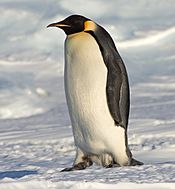 |
Aptenodytes Miller,JF, 1778 – great penguins |
|
 |
Pygoscelis Wagler, 1832 – brush-tailed penguins |
|
 |
Eudyptula Bonaparte, 1856 – little penguins |
|
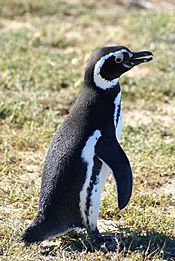 |
Spheniscus Brisson 1760 – banded penguins |
|
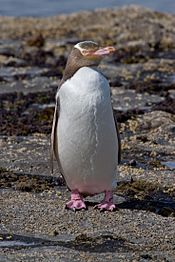 |
Megadyptes Milne-Edwards, 1880 |
|
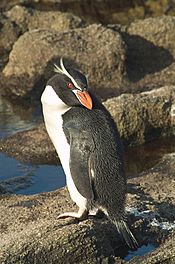 |
Eudyptes Vieillot, 1816 – crested penguins |
|
Images for kids
-
Adélie penguin (Pygoscelis adeliae) feeding young. Like its relatives, a neatly bi-coloured species with a head marking.
-
Magellanic penguins (Spheniscus magellanicus). The closed neck collar denotes this species.
-
Southern rockhopper penguin (Eudyptes chrysocome) displaying its distinctive crest
-
Two king penguins and one gentoo penguin on a beach on South Georgia, British overseas territory
-
Penguin tracks in the sand on Bruny Island, Tasmania
-
Gentoo penguin swimming underwater at the Nagasaki Penguin Aquarium
See also
 In Spanish: Pingüinos para niños
In Spanish: Pingüinos para niños



